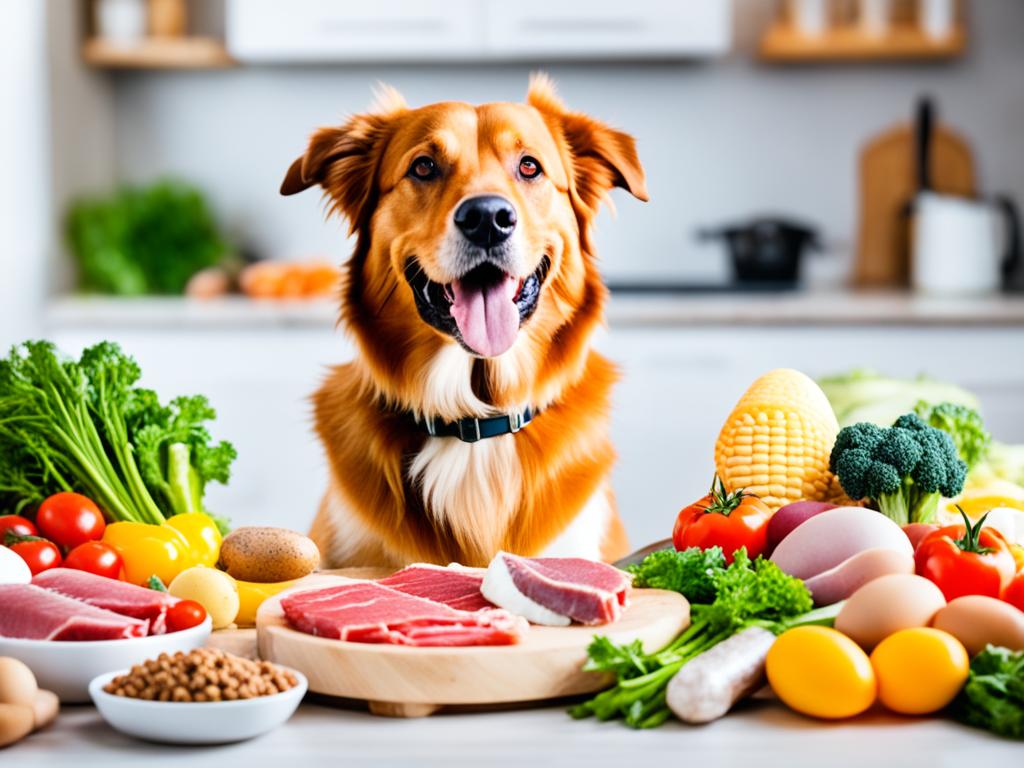
Switching Your Dog to a Raw Food Diet Safely, Did you know that more and more dog owners are transitioning their furry friends to a raw food diet? It’s true! Raw diets for dogs have been gaining popularity due to their potential health benefits and closer resemblance to a dog’s natural diet in the wild. If you’re considering making the switch for your own canine companion, it’s important to do it safely and effectively. In this article, we’ll explore the steps you can take to transition your dog to a raw food diet without any digestive issues or discomfort.
Key Takeaways:
- Transitioning your dog to a raw food diet can offer numerous health benefits.
- It’s crucial to make the switch gradually and ensure your dog’s individual needs are met.
- Be prepared for potential changes in your dog’s stool consistency and water intake.
- Offer a variety of meat sources and gradually increase the amount of raw food in their meals.
- Consult with a veterinarian or seek guidance from reliable resources.
- If handling Meat is not for you then try freeze dried products.
- Understanding Your Dog’s Initial Reaction to Raw Food
- Strategies for Making Raw Meals Attractive
- Transitioning from Kibble to Raw: A Step-by-Step Guide
- Switching Your Dog to a Raw Food Diet Safely
- Assistance in Transitioning Dog to Raw Diet
- Addressing Digestive Issues and Detoxification
- Conclusion, Switching Your Dog to a Raw Food Diet Safely
Understanding Your Dog’s Initial Reaction to Raw Food
When you first introduce raw food to your dog, their initial reaction may differ from their previous diet. It is important to understand what to expect during this transition period to ensure your dog’s well-being.
One of the immediate changes you may notice is in their stool consistency and frequency. Raw food has a higher moisture content, which can result in softer stools. This is a normal adjustment as their digestive system adapts to the new diet. Monitoring their stool and adjusting their diet accordingly will help maintain their comfort.
Additionally, your dog’s water intake might decrease when switching to raw food. This is because raw food naturally contains more moisture, reducing the need for additional water consumption. However, it’s important to provide clean, fresh water throughout the day to keep your dog hydrated.
Understanding these changes and being prepared for them will make the transition smoother for both you and your dog. Remember to monitor their stool, adjust their diet accordingly, and provide plenty of water to ensure their comfort and well-being.
Transitioning your dog to a raw food diet can be a beneficial choice for their overall health. By introducing raw food gradually and being mindful of their individual needs, you can provide them with a nutritious and balanced diet.”
Strategies for Making Raw Meals Attractive
When transitioning your dog to a raw food diet, it’s important to make their meals as appealing as possible. By using various strategies, you can increase their interest and enthusiasm for raw food. Here are some steps to introduce raw food to your dog and create a raw food meal plan that will entice them:
Variety of Meat Sources
Introduce a variety of different meat sources over time to provide a diverse range of flavors and nutrients. Start with game meat such as venison or rabbit, as it doesn’t contain bones and is easier to digest. Gradually incorporate other meats like chicken, beef, and fish to offer a balanced diet. This variety will keep your dog engaged and excited during mealtime.
Gradual Transition
Begin the transition by mixing a small amount of raw food with their current kibble. Over time, gradually increase the proportion of raw food while decreasing the amount of kibble. This gradual transition allows your dog’s digestive system to adapt to the new diet while ensuring they receive the necessary nutrients from both the raw food and kibble.
Fresh and High-Quality Ingredients
Ensure that the meat you offer is fresh and of high quality. Opt for organic or human-grade meats to provide the best nutritional value for your dog. Fresh ingredients will have a stronger aroma and taste, making them more enticing to your dog. It’s essential to prioritize their health by providing them with raw food that meets their nutritional needs.
By following these steps and incorporating these strategies, you can make the raw meals attractive and enjoyable for your dog. The key is to introduce a variety of meat sources gradually and use fresh, high-quality ingredients to ensure their raw food meal plan is well-balanced and nutritious.
| Strategies | Benefits |
|---|---|
| Incorporate variety of meat sources | Provides diverse flavors and nutrients |
| Gradual transition | Allows the digestive system to adapt |
| Use fresh and high-quality ingredients | Ensures nutritional value and better taste |
Remember, each dog is unique, and their preferences may vary. Be patient and observant during the transition, making adjustments as necessary to ensure a successful switch to a raw food diet.
Transitioning from Kibble to Raw: A Step-by-Step Guide
Transitioning your dog from kibble to a raw food diet can be a smooth and successful process when done correctly. There are two main approaches you can take: the rapid switch or the slower switch. Let’s explore both methods to help you decide which one is best for your furry friend.
The Rapid Switch
If you have a healthy young dog or puppy, the rapid switch may be the best option for you. This method involves switching your dog’s diet entirely from kibble to raw food overnight. The sudden change can work well for dogs with robust digestive systems, who can adapt quickly to new diets. However, it’s essential to ensure that the raw food you’re providing is nutritionally balanced and meets your dog’s dietary needs.
The Slower Switch
For dogs that may have a more sensitive stomach or are used to a routine, a slower transition can be a better choice. This method involves gradually reducing the amount of kibble in your dog’s meals while increasing the amount of raw food over a period of seven days or more. This gradual transition allows your dog’s digestive system to adjust to the new diet without causing any discomfort, raw food bowls are also a good addition to stop your dog from eating to fast.
The length of the transition period will depend on factors such as your dog’s age, weight, and activity level. It’s important to monitor your dog’s response to the new diet and make adjustments as necessary along the way.
Here’s a sample schedule for a 7-day transition:
| Day | Kibble | Raw Food |
|---|---|---|
| Day 1 | 100% | 0% |
| Day 2 | 75% | 25% |
| Day 3 | 50% | 50% |
| Day 4 | 25% | 75% |
| Day 5 | 0% | 100% |
Remember to adjust the transition schedule based on your dog’s individual needs. If your dog experiences any digestive issues or discomfort during the transition, it’s best to consult with a veterinarian for guidance.
Switching Your Dog to a Raw Food Diet Safely
By following these best practices and taking into consideration your dog’s unique requirements, you can smoothly transition them from kibble to a raw food diet. Remember to monitor their well-being throughout the process and seek professional advice if needed. Before you know it, your dog will be enjoying the many benefits of a raw food diet!
Assistance in Transitioning Dog to Raw Diet
If you’re looking for guidance and support in transitioning your dog to a raw food diet, We Feed Raw is here to help. With their expertise and resources, you can confidently make the switch and ensure that your dog receives a balanced and nutritious diet. Whether you’re new to raw feeding or have previous experience, We Feed Raw provides valuable information and tips to make the transition a success.
Getting started with We Feed Raw is easy. They offer comprehensive information on how to begin the process and what to expect during the transition. Their step-by-step approach ensures that you have a clear understanding of the necessary changes in your dog’s diet and how to implement them.
Transitioning your dog to a raw food diet requires careful consideration of their individual needs. We Feed Raw provides helpful tips on adjusting portion sizes, introducing new ingredients, and monitoring your dog’s progress. This guidance ensures that your dog’s nutritional requirements are met throughout the transition.
We Feed Raw understands that every dog is unique, and they offer tailored advice to address specific challenges or concerns you may encounter along the way. Their experienced team is available to answer your questions and provide support, making the transition to a raw diet a smooth and successful journey.
“Transitioning your dog to a raw food diet can be a significant step towards their overall health and well-being. We Feed Raw is dedicated to assisting pet owners in this process, offering expert guidance, and ensuring that your dog receives a balanced and nutritious diet.”
With We Feed Raw’s expertise and commitment to quality, you can feel confident in your decision to transition your dog to a raw food diet. Explore their resources, follow their valuable tips, and give your furry friend the benefits of a natural and wholesome diet.
Stay tuned for the next section, where we will discuss addressing digestive issues and detoxification during the transition to a raw food diet.
Addressing Digestive Issues and Detoxification
When transitioning your dog to a raw food diet, it is not uncommon for them to experience digestive issues or detoxification symptoms. These can include loose stools, increased mucus, and temporary shedding. While these symptoms may be temporary and part of the adjustment process, it is important to address them promptly to ensure your dog’s comfort and well-being.
To address digestive issues and detoxification symptoms during the transition to a raw food diet, consider the following strategies:
- Gradual transition: Instead of making an abrupt switch, gradually introduce raw food into your dog’s diet over a period of time. This allows their digestive system to adapt more easily and reduces the chances of digestive upset.
- Softer or ground food: If your dog is experiencing difficulty digesting raw food, try feeding them softer or ground food initially. This can be more gentle on their digestive system and make the transition smoother.
- Digestive supplements: Consult with a veterinarian about the use of digestive supplements during the transition. These supplements can help support your dog’s digestive health and ease any discomfort they may be experiencing.
It is important to closely monitor your dog’s health throughout the transition process. If the digestive issues or detoxification symptoms persist or worsen, it is advisable to seek guidance from a veterinarian. They can provide personalized advice and ensure that your dog’s transition to a raw food diet is successful and free from any digestive complications.
Transitioning your dog to a raw food diet should be a gradual and mindful process. By addressing any digestive issues or detoxification symptoms that may occur, you can help ensure a smooth and successful transition to a raw diet that promotes your dog’s overall health and well-being.
Conclusion, Switching Your Dog to a Raw Food Diet Safely
Transitioning your dog to a raw food diet can bring about a multitude of benefits for their overall health and well-being. By taking the right steps and being patient throughout the process, you can provide your furry companion with a nutritious and balanced diet that supports their digestive system, increases their energy levels, promotes a healthier coat, and contributes to their overall vitality.
During the transition, it is crucial to address any challenges or issues that may arise, such as digestive issues or detoxification symptoms. Monitoring your dog’s progress and consulting with a veterinarian for personalized advice and guidance can help ensure a successful transition and optimal results.
Remember, each dog is unique, and it may take some time for them to adjust to the new diet. By remaining consistent and gradually introducing raw food into their meals, you can help your dog embrace a raw food diet and enjoy its many benefits.











